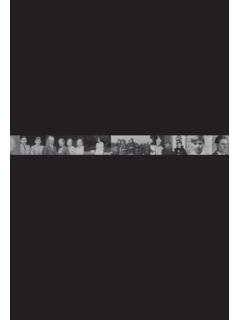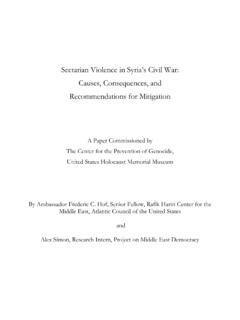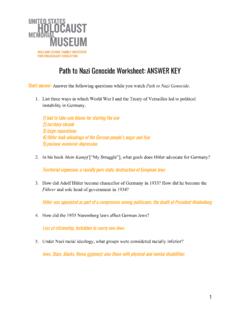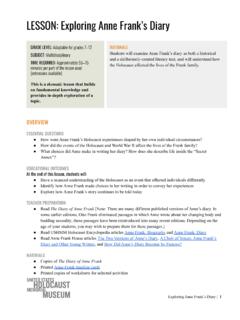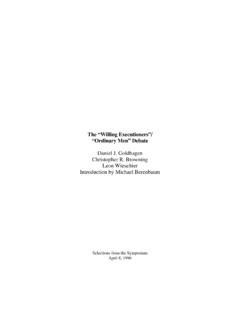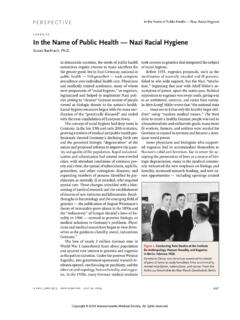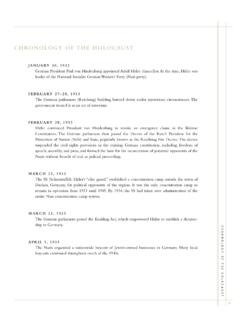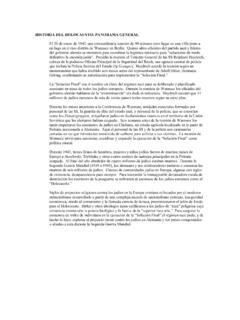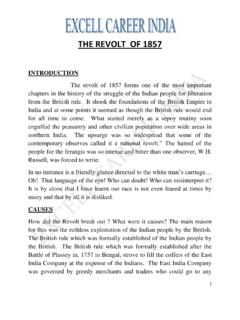Transcription of From Independence to Civil War - ushmm.org
1 From Independence to Civil War Atrocity Prevention and US Policy toward South Sudan Jon Temin July 2018 S IM ON-S K J OD T C E N T E R F OR T H E P R E V E N T I ON OF GE N O C ID E 2 CONTENTS Foreword .. i Executive Summary .. 1 Introduction .. 4 Project Background .. 7 The South Sudan Context .. 9 Post-Benghazi, Post-Rwanda .. 9 Long US History and Friendship .. 10 Hostility Toward Sudan and Moral Equivalence .. 11 Divergent Perceptions of Influence and Leverage .. 11 Pivotal Periods .. 13 1. Spring/Summer 2013: Opportunity for Prevention? .. 13 2. Late 2013/Early 2014: The Uganda Question .. 17 3. Early 2014: Arms Embargo A Missed Opportunity .. 22 4. Spring/Summer 2016: Misreading the Moment .. 26 Recurring Critical Questions .. 34 1. Should They Both Have Been Forced to Go? .. 34 2. Is the CPA to Blame? .. 36 Conclusions and Implications .. 40 Question Legitimacy, Even of Erstwhile Allies .. 40 Do Not Overvalue Relationships .. 41 Challenge Assumptions, Especially When Mass Atrocities Are Involved.
2 42 Make a Decision on US Investment, and Stick to It .. 44 U N IT E D S T A T E S H OL OC A U S T M E M OR I A L M U S E U M i Foreword The Civil war in South Sudan has resulted in some of the most severe, deliberate violence against civilians since the Rwandan genocide. Although Americans see little of South Sudan on the nightly news, for nearly five years South Sudanese civilians have been subjected to mass killing, widespread sexual violence, torture, and other atrocities. The violence, which continues unabated, has displaced more than four million people, at least one-third of the country s population. The targeting of civilians on the basis of ethnicity has led credible observers, including the UN special adviser on the prevention of genocide, to warn on multiple occasions of the very real possibility of genocide. Since the war began in December 2013, the Museum has attempted to shine a spotlight on ongoing atrocities in South Sudan. We have shared the stories of South Sudanese victims, supported reporting and photojournalism to document the severity of the abuses, and pressed for more sustained policy efforts to address South Sudan s atrocity crisis.
3 In addition, the Museum s new Ferencz International Justice Initiative is working in collaboration with South Sudanese activists to strengthen prospects for justice and accountability for these crimes. These activities reflect the Museum s mandate to catalyze global action to prevent genocide and mass atrocities. The Museum s mission, at the same time, demands that we try to learn from failed attempts to prevent and respond to the violence in South Sudan. Indeed, the institution was founded, in Elie Wiesel s words, as a living memorial to the victims of the Holocaust, on the conviction that the history of catastrophe holds lessons that can help build a better future. Therefore, in late 2017 we asked Jon Temin, a longtime expert on conflict in Sudan and South Sudan and a former member of the State Department s policy planning staff, to conduct research into the US government s policy response to mass atrocities in South Sudan since the country gained its Independence in 2011.
4 We hope that this analysis will help current and future policy makers focused on South Sudan and other atrocity crises around the world. Learning lessons from past cases of international response, including through reflection and analysis by former officials, is a longstanding theme of the Museum s efforts to conduct policy-relevant research about genocide and mass atrocities and their prevention. We often have engaged former senior government officials soon after they have left government service to reflect on their experiences as insiders in order to draw lessons, determine best practices, and create an informal record of the actions taken and processes followed. We hope future generations of scholars and officials can learn from these efforts and apply those lessons to future cases. In the cases of Rwanda, Srebrenica, Central African Republic, and Syria, our lessons-learned studies of Clinton, George W. Bush, and Obama-era efforts have attempted to understand how US and international policy officials responded or did not respond to new or ongoing atrocities.
5 They have detailed the effects of these decisions and how those lessons might be applied to potential future instances of genocide and mass atrocities. Based on extensive interviews with US policy makers and other experts, Temin s analysis provides rich detail about the deliberations and debates over South Sudan policy. The report focuses principally on S IM ON-S K J OD T C E N T E R F OR T H E P R E V E N T I ON OF GE N O C ID E ii diplomatic efforts to prevent and later resolve the war, given that the conflict itself has been the central driver of atrocities against civilians. Unfortunately, prospects for a resolution to the Civil war continue to be dim. It is also vital, therefore, to debate actions that can be taken in the midst of the war to protect still-vulnerable populations. Although the South Sudan case has some distinctive characteristics, Temin s core conclusions to challenge the legitimacy of governments responsible for atrocities, not to overvalue our own leverage, to question core assumptions, and to decide how much to invest in resolving a crisis are important general admonitions for US policy makers in this area of work.
6 In addition to these points, we also see in Temin s analysis of South Sudan several points of resonance with recurring policy challenges that the United States faces in responding to mass atrocity crises. For example: The debate about whether the United States should have called for President Salva Kiir and Vice President Riek Machar to retire from South Sudanese politics or continue trying to facilitate a negotiated agreement between them echoes dilemmas faced most recently in Syria, but also in the Balkans in the 1990s. In discussing the failed negotiated agreement between the warring parties, which the subregional organization mediated, Temin highlights the risks of holding on to false hope for a peace deal that is either deeply flawed from the start or has been cast aside by the parties. This point recalls the international community s stubborn commitment to the Arusha Accords in the early 1990s, even while signs emerged that Hutu extremists in Rwanda were preparing to exterminate the Tutsi and moderate Hutu populations.
7 Finally, Temin points to the negative consequences for US policy of having vacancies in senior policy and diplomatic positions. A similar problem was observed in the US response to escalating conflict in Central African Republic in 2013, when the United States lacked an ambassador or other senior diplomat at critical moments. That many of the situations Temin analyzes echo the progression of other recent crises suggests that identifying lessons is just the first step. More effective action will come only when these lessons are truly absorbed and incorporated into US government policy and practice, and when leaders are willing to take promising, if necessarily uncertain actions to prevent atrocities. By continuing to tell the human stories of genocide and mass atrocities, studying successes and failures, and serving as a resource to policy makers, the Museum strives to advance the goal of turning lessons into effective action. Lawrence Woocher Research Director Simon-Skjodt Center for the Prevention of Genocide July 2018 U N IT E D S T A T E S H OL OC A U S T M E M OR I A L M U S E U M 1 Executive Summary Could the Civil war in South Sudan have been prevented?
8 Could some of the violence and misery caused by the war have been avoided? Those questions are academic in some ways, as so much damage has been done. But in other ways, seeking answers is vital because patterns of violence in the 21st century suggest there will be more wars that resemble the South Sudan conflict: (a) fought within a country s borders, (b) fought between multiple groups that regularly fragment and realign, (c) driven in part by access to lucrative natural resources and capture of state coffers, (d) with civilians often targeted, and (e) in which the lines between civilians and combatants are sometimes blurred. When the threat of such state collapse appears elsewhere and we should expect that it will lessons from the South Sudan experience will be valuable. This project seeks to identify some of those lessons by examining US policy toward South Sudan in the years leading up to and during the Civil war. President Barack Obama s administration placed an emphasis on atrocity prevention, and South Sudan s Civil war was the source of some of the most egregious atrocities anywhere during his time in office.
9 The author conducted in-depth interviews with more than 30 former and current American officials (from the Obama and George W. Bush administrations), South Sudanese experts, and longtime observers of South Sudan from the think tank, nongovernmental organization (NGO), and academic communities. Through those interviews, the author sought to identify pivotal periods in US policy making, short stretches of time during which events in South Sudan compelled the United States to act or, in hindsight, times at which the United States could have acted with greater conviction but did not. This report identifies four such periods. For each, the author seeks to identify alternative policies that could have been considered and to assess whether those policies may have been able to prevent or limit violence. These are the four periods: 1. The spring and summer of 2013, when it was increasingly clear that major fissures in the ruling Sudan People s Liberation Movement (SPLM) were likely to trigger violence violence that erupted in December 2013.
10 A series of warning signs throughout the year suggested that political and ethnic tensions within the SPLM and within broader society were escalating. Senior American officials were warned directly by at least one senior South Sudanese official that the SPLM was fragmenting and struggling to manage difficult succession issues. Some observers in and outside the US government viewed the likelihood of a calamitous war as rapidly increasing, although a more optimistic narrative prevailed in other quarters. Preemptive action was required to reverse the negative trends, but the United States was reluctant to directly and forcefully engage, and at that critical time, several key senior policy positions were unfilled. 2. December 2013 and early 2014, when the Ugandan People s Defense Force (UPDF) intervened in South Sudan, soon after fighting started in the capital, Juba. The UPDF intervention was initially greeted with appreciation, including by the international community, as the intervention may have prevented significantly greater violence in Juba and surrounding areas and helped S IM ON-S K J OD T C E N T E R F OR T H E P R E V E N T I ON OF GE N O C ID E 2 secure diplomatic compounds and other critical infrastructure in the city.
